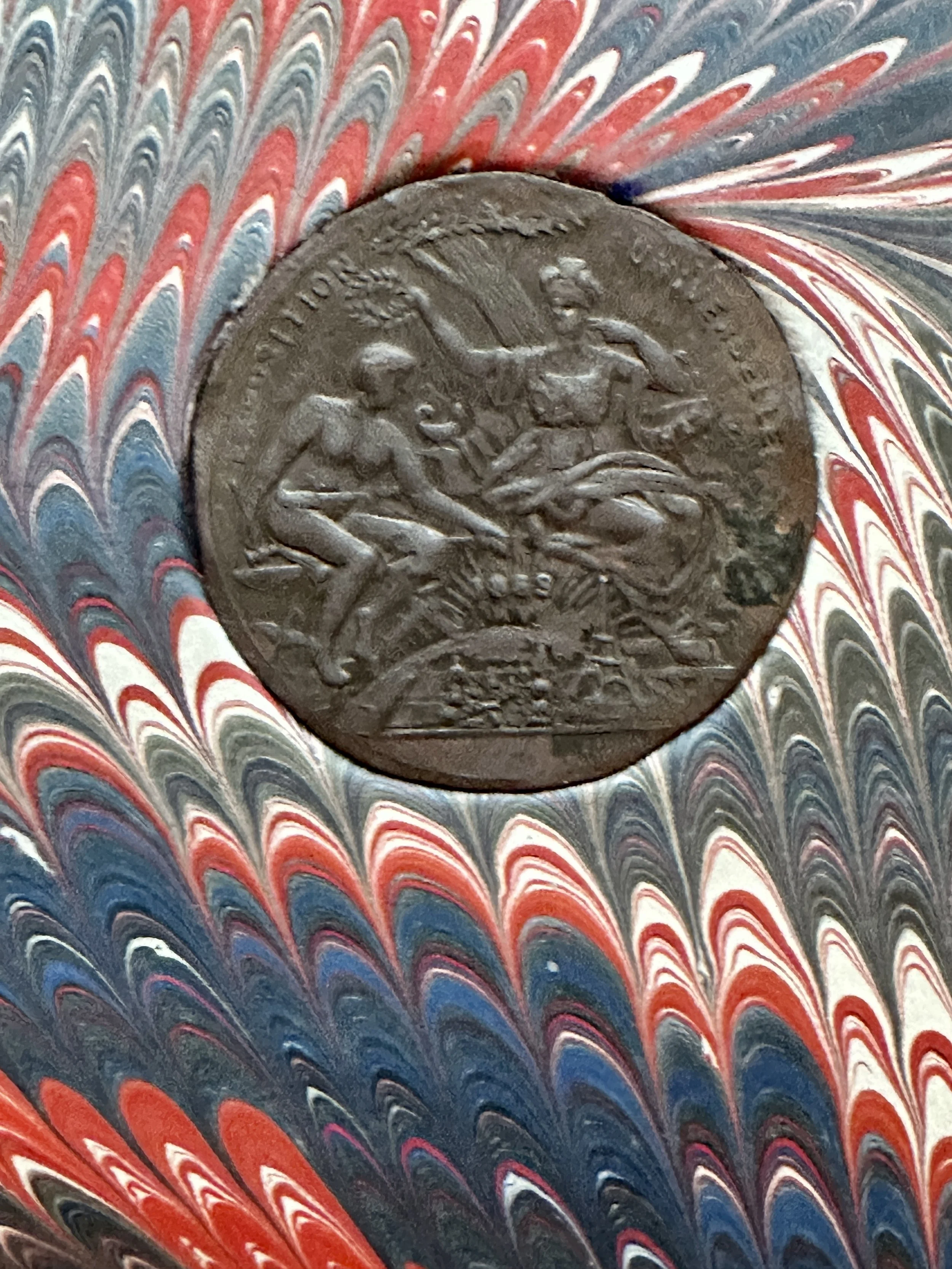Exposition Universalle
This archival, hand-sewn journal/sketchbook is made from 100 gsm, rose Hahnemühle Ingres mouldmade paper from Germany, sewn with Irish linen thread in the linked stitch pattern that dates back at least to the Ancient Copts. It allows the book to lay open easily to any page.
This book’s endbands are brown and yellow cotton, and its bookmark is pigskin. The spine of this book is covered in chrome-free tanned pigskin, and its boards are wrapped in paper that was hand-marbled by Betty Caponi in San Monte Giusto, Italy.
Treasure binding began with monks in the 6th Century who would encrust volumes with jewels. During the Renaissance, there was a resurgence in treasure binding. This is a contemporary revival of the treasure binding in which a lucky charm has been embedded in the cover of this book.
The talisman in this book is a commemorative visitor’s token from the 1889 Exposition Universalle in Paris, and it shows an image of the Eiffel Tower from the year it opened. The Eiffel Tower was meant to come down after the World’s Fair, but Parisians, who first scorned it as being too industrial, came to love it and have preserved it ever since. You might just jot a few notes in this book from time to time, and the future may revere them. You just never can tell.
This book is roughly 6.5 x 10” with a few more than 150 blank pages.
This archival, hand-sewn journal/sketchbook is made from 100 gsm, rose Hahnemühle Ingres mouldmade paper from Germany, sewn with Irish linen thread in the linked stitch pattern that dates back at least to the Ancient Copts. It allows the book to lay open easily to any page.
This book’s endbands are brown and yellow cotton, and its bookmark is pigskin. The spine of this book is covered in chrome-free tanned pigskin, and its boards are wrapped in paper that was hand-marbled by Betty Caponi in San Monte Giusto, Italy.
Treasure binding began with monks in the 6th Century who would encrust volumes with jewels. During the Renaissance, there was a resurgence in treasure binding. This is a contemporary revival of the treasure binding in which a lucky charm has been embedded in the cover of this book.
The talisman in this book is a commemorative visitor’s token from the 1889 Exposition Universalle in Paris, and it shows an image of the Eiffel Tower from the year it opened. The Eiffel Tower was meant to come down after the World’s Fair, but Parisians, who first scorned it as being too industrial, came to love it and have preserved it ever since. You might just jot a few notes in this book from time to time, and the future may revere them. You just never can tell.
This book is roughly 6.5 x 10” with a few more than 150 blank pages.
This archival, hand-sewn journal/sketchbook is made from 100 gsm, rose Hahnemühle Ingres mouldmade paper from Germany, sewn with Irish linen thread in the linked stitch pattern that dates back at least to the Ancient Copts. It allows the book to lay open easily to any page.
This book’s endbands are brown and yellow cotton, and its bookmark is pigskin. The spine of this book is covered in chrome-free tanned pigskin, and its boards are wrapped in paper that was hand-marbled by Betty Caponi in San Monte Giusto, Italy.
Treasure binding began with monks in the 6th Century who would encrust volumes with jewels. During the Renaissance, there was a resurgence in treasure binding. This is a contemporary revival of the treasure binding in which a lucky charm has been embedded in the cover of this book.
The talisman in this book is a commemorative visitor’s token from the 1889 Exposition Universalle in Paris, and it shows an image of the Eiffel Tower from the year it opened. The Eiffel Tower was meant to come down after the World’s Fair, but Parisians, who first scorned it as being too industrial, came to love it and have preserved it ever since. You might just jot a few notes in this book from time to time, and the future may revere them. You just never can tell.
This book is roughly 6.5 x 10” with a few more than 150 blank pages.








